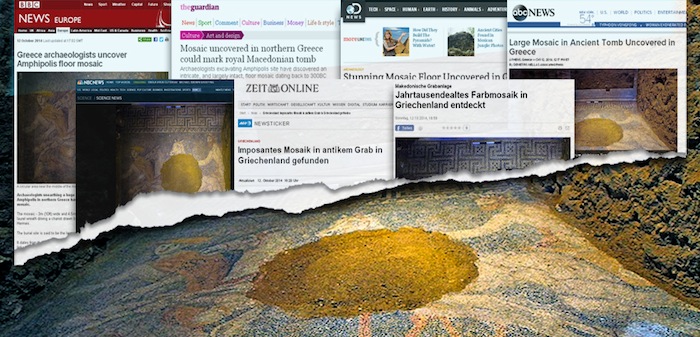
BBC reports that the mosaic, three meters wide and 4.5 meters long, depicts a man wearing a laurel who rides a chariot. He’s guided by the god Hermes. The report also says that the Kasta hill tomb, the biggest such monument ever discovered in Greece, dates to the end of the 4th century BC. “Some observers say the tomb could belong to a member of Alexander’s immediate family – maybe his mother, Olympias, or his wife, Roxana – or another Macedonian noble. Others believe it could be a cenotaph, a monument built in honor of a person whose remains are elsewhere,” reads the report.
Discovery News has published an article entitled “Stunning Mosaic Floor Uncovered in Greece’s Mystery Tomb.”
“A big piece of a fascinating mosaic depicting a chariot in motion was discovered in the Amphipolis burial complex in northern Greece. Created with small white, black, blue, red, gray and yellow tesserae, the mosaic came to light when archaeologists led by Katerina Peristeri removed the earth from the second chamber behind the massive Caryatids,” the report says.
The Discovery report also features a comment by archaeologist Dorothy King, who writes: “The figure is clearly Hermes, and that is clear from his insignia which are standard iconography and seen in a number of Macedonian tombs.”
King speculates further: “But who is the bearded man in the chariot being led by Hermes? The profile depiction to me suggests that it is Philip II,” she says. “The bearded man with a laurel wreath on his head is shown in profile, hiding the right side of his face. Philip lost his right eye, but also won a wreath at the Olympic games. This is probably Philip II and his horses, adding to the idea that this was a tomb or shrine glorifying Alexander. Philip II died so that Alexander might become Great.”
“Large mosaic in ancient tomb uncovered in Greece,” reads the title of the Associated Press report, also reproduced by networks and newspapers such as the Daily Mail, Fox News, the Miami Herald, the NZ Herald and ABC News. The report references a comment by the Greek Ministry of Culture: “… archaeologists have dated the mosaic to the last quarter of 4th century B.C. (325-300 B.C.), consistent with their belief the grave contains the remains of a contemporary of Alexander the Great… The grave may be that of a relative or general of Alexander’s, archaeologists have speculated.”
Concerning the mosaic, the AP report adds, “A circular part, near the center of the mosaic, is missing, but authorities say enough fragments have been found to reconstruct a large part.”
“Holy Hermes! Mosaic Revealed in Greece’s Amphipolis Tomb,” reads the witty title of the NBC News report.
See all the latest news from Greece and the world at Greekreporter.com. Contact our newsroom to report an update or send your story, photos and videos. Follow GR on Google News and subscribe here to our daily email!



